Clothes Dryer Vents: The Proper and The Improper

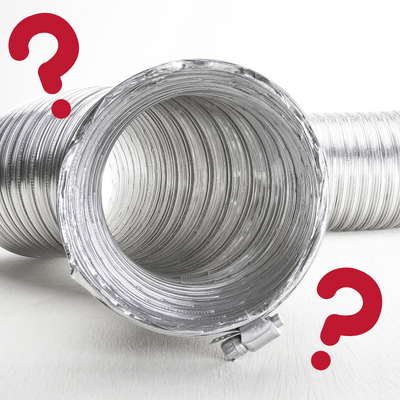
I continually run into confusion from homeowners and Realtors regarding what the proper venting material should be for clothes dryers. Statistics from the Consumer Product Safety Commission (CPSC) show that over 15,000 house fires and nearly $100 Million in property damage annually are related to faulty clothes dryer vent installations in the US. House fires related to clothes dryer vents are more common than most people believe but, luckily, are relatively easy to prevent. The inside of many dryer vents is extremely dirty and most people would have no idea until they either (1.) have a fire, or (2.) decide to finally clean out their clothes dryer vent years after it should have been done.
Clean the lint filter and the lint filter compartment
In addition to the easily removeable lint trap filter that comes with all clothes dryers, the compartment where the lint trap filter resides tends to fill with lint and this area rarely, if ever, gets cleaned. It can be difficult to access for most dryers but often has a cover that is secured in place with a few screws. Besides cleaning the lint filter each time a load of laundry is done, the area adjacent to or below the lint filter also needs to be cleaned out regularly. This often requires using a vacuum cleaner with a hose attachment, for example, after the cover is removed. Cleaning the lint filter AND removing the lint in the compartment adjacent to or below where the lint filter is installed is very important.
Improper Dryer Vent Materials
During a normal drying cycle, up to a gallon of water may be drawn out of the clothes in the form of water vapor. The purpose of the dryer vent system is to transport this water vapor and the lint that accompanies it, as well as heat, to a safe location outside the home. A commonly found yet improper type of dryer vent is flexible vinyl tubing. Vinyl is a type of plastic and which can easily melt and lead to a house fire. This material, most often white and ribbed, tends to allow for lint to readily accumulate inside of it. Lint is very flammable and all it takes is a small spark to ignite it leading to a house fire. The more lint that fills a clothes dryer vent, the more energy the clothes dryer consumes to try to dry the clothes as air won’t freely flow through the clogged vent material. This, in turn, causes the drying cycle to be much longer (maybe 2 or 3 hours) than normal and raises utility bills. The photo below shows vinyl (plastic) tubing.
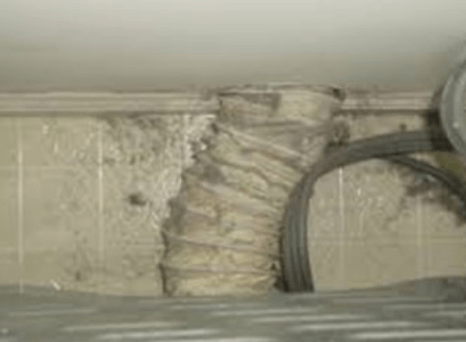
Another improper dryer vent material that I routinely see installed is mylar foil tubing (see photo below). It is a flexible ribbed (slinky-like) shiny tubing that many homeowners and contractors have installed wrongly assuming that it is metal because it is shiny. Mylar foil tubing is not approved for use as a clothes dryer vent material and should not be used for this application. The photo below shows an installation of mylar foil tubing which actually runs behind a fixed wall covering. A new product on the market (DryerFlex) looks similar to mylar but is UL 2158A approved and is more rigid than mylar foil tubing. A transition duct is the piece of ducting that connects the clothes dryer to the actual clothes dryer vent.
If the mylar transition duct is UL approved, it will have a UL sticker on it stating "UL 2158A". If it has no UL 2158A sticker, then it should be assumed it is not UL listed and should be replaced with a proper rigid metal dryer vent material. The transition duct should be as short as possible to connect the dryer to the metal vent (no longer than 8'). The transition duct must not run within a wall, floor, or ceiling covering since it will not be able to be visually inspected and can't easily be cleaned
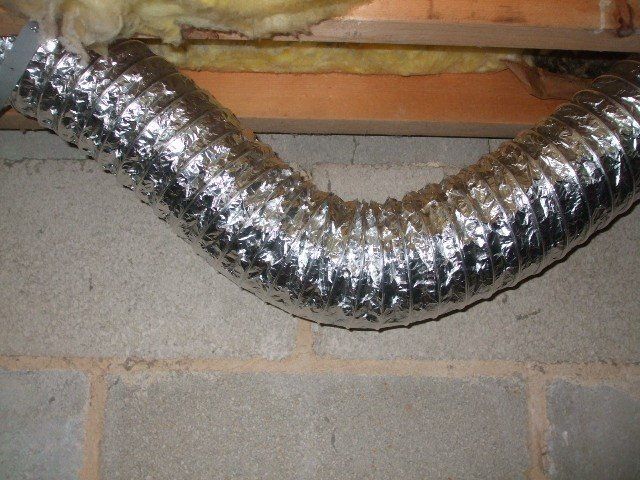
Something that I’ve been running across sometimes is that some builders installed 4” PVC drainpipe as the clothes dryer duct. At one inspection from several years ago, I even saw a black corrugated plastic drainpipe (normally used for draining water from downspouts) being used as the home’s dryer vent. While PVC is meant for plumbing and venting applications, PVC is not approved for venting a clothes dryer as it is not heat rated. PVC pipe should not be used for this application. The photo below from a recent home inspection shows vinyl tubing (left side) connected to PVC pipe (right side) with cloth duct tape. These materials are wrong.
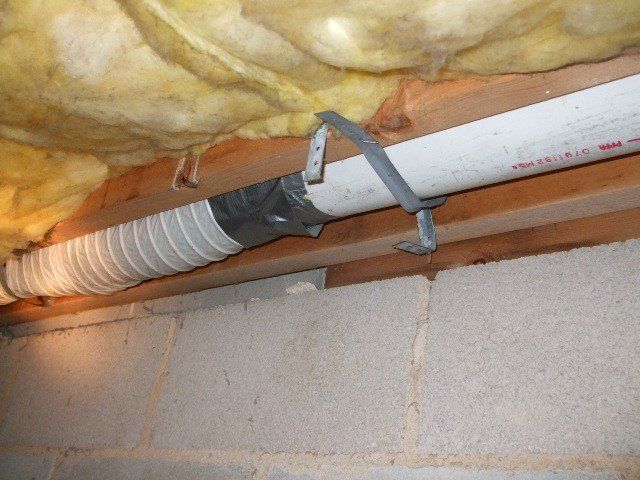
The IRC (International Residential Code) section M1501 requires that clothes dryer vents be constructed of, at least, 0.016" thick rigid metal, have smooth interior surfaces, and shall not have sheet metal screws extending into the duct. The clothes dryer vent should meet the UL 2158A standard. Sheet metal screws penetrating into the material allow lint to get caught on the screws and possibly clog the vent over time (see the right-side photo below). Keep in mind, that a home inspection is not a code compliance inspection and that the AHJ (authority having jurisdiction) is the responsible party for determining/verifying code compliance. The home inspector is using these standards, however, as a reference to help protect his client from possible future hazards, such as a house fire. The first photo below shows the proper rigid metal duct material. Notice how this rigid metal duct looks nothing like the mylar foil material. This material can't easily be bent.
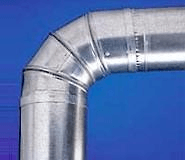
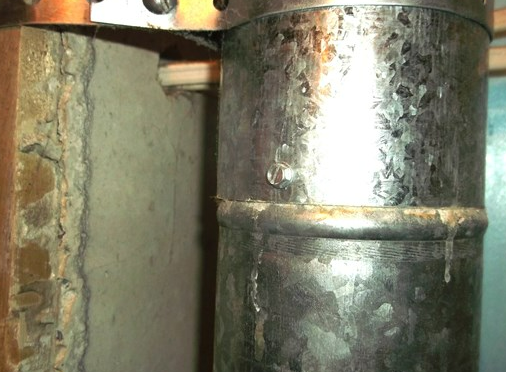
Dryer ventilation systems should terminate to the home’s exterior and have a proper exterior cover to help prevent water, birds, insects, etc. from entering the duct. The IRC also specifically forbids having an exterior screen installed on the dryer vent, like the vent shown to the right. These screens often catch lint and then block the dryer vent over time. Luckily, these screens can often be easily removed leaving the dampered or louvered cover in place.
Venting a clothes dryer into a garage, basement, attic, or anywhere else inside the home can lead to excessively high humidity levels, mold, as well as an increased fire risk. Also, a clothes dryer ventilation line should terminate to an area of the home’s exterior where it cannot be blocked by vegetation, snow, dirt, etc. and be at least 3 feet from doors and windows. The vent also should not terminate near an A/C or heat pump outside unit as lint can accumulate on the unit and prevent proper operation of the system.
Semi-flexible rigid metal ducting is recommended where the rigid metal duct material connects to the clothes dryer, however, the flexible pieces should never be installed within walls or ceilings due to their lack of access for cleaning. The photo below shows flexible rigid metal ducting. Again, notice how different this material below looks compared to the mylar foil ducting.
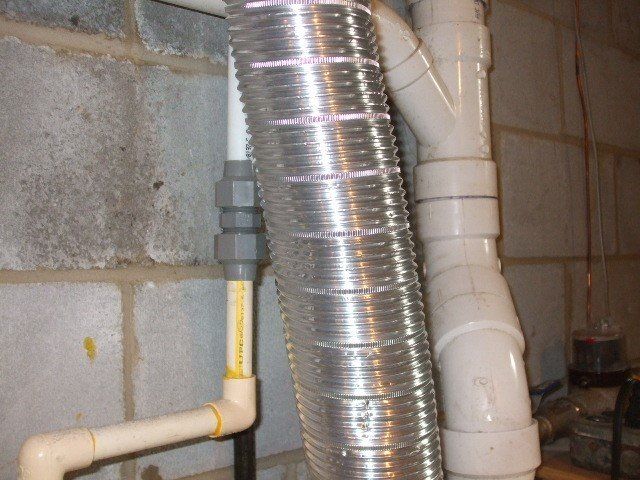
I sometimes find dryer vents that far exceeding 40 feet in length. In this case, I recommend that the vent system be modified to terminate to an alternate exterior location closer to the laundry appliances to allow a shorter run. Most standards call for clothes dryer vents to be no more than 35 feet in length, have few bends, and no kinks. The more bends in the vent that exist, the shorter the overall length should be. For every 90° bend, the vent should be shortened by 5 feet; for every 45° bend, the vent should be shortened by 2.5 feet. An exception exists if the clothes dryer’s manufacturer specifically permits a longer vent but, in most cases, the inspector does not have this documentation from the clothes dryer’s manufacturer. Some clothes dryer manufacturers will mention in their installation materials whether they allow an in-line booster fan to be used when there is no easy way to prevent a long dryer vent.
As part of a home inspection, the inspector should report whether the clothes dryer vent is visible, its apparent type and condition, and recommend modification if any of the safety issues noted above are found. If the vent is not visible (such as passing through walls/ceilings or insulation), the home buyer should verify that a proper rigid metal vent is installed and find out from the seller when it was last cleaned.
With every home inspection, I always recommend that the clothes dryer vent and exterior cover be thoroughly cleaned, at least, twice per year as preventative maintenance. This also reminds the homeowner to ensure that the vent hasn't come loose behind the dryer or at the louvered or dampered exterior termination point. In cases where the full length of dryer vent is relatively short and fully accessible, the homeowner can take apart and clean the dryer vent’s interior; this is made easier with a vacuum cleaner with a long hose attachment. In cases where the vent is long or located within a wall or ceiling, a professional should do the job. Many HVAC professionals and chimney sweeps also perform dryer vent cleaning and there are a few companies that specifically clean clothes dryer vents as their main business.
During a home inspection, in many cases, only a small part of the clothes dryer vent is visible and, sometimes, none of the vent is visible. Often, socks or other clothing have fallen behind the laundry appliances against the wall and these items can block sight of the dryer vent where it passes into a wall or floor. Installed insulation, ceilings, or walls as well as other nearby stored items can block visual access to the dryer vent material. Of course, home inspectors do not move insulation, disassemble walls/ceilings, or move appliances to perform the inspection so visual or physical access to the dryer vent is sometimes limited or totally blocked.
House fires related to improper or blocked dryer vents are easily prevented and a little bit of preventive maintenance can help save lives.
When was the last time you inspected and cleaned your clothes dryer vent? Your family's safety may depend on it.
Facts, opinions and information expressed in the Blog represent the work of the author and are believed to be accurate, but are not guaranteed. The Lancaster County Association of Realtors is not liable for any potential errors, omissions or outdated information. If errors are noted within a post, please notify the Association. Posts represent the author's opinion and are not necessarily the opinion of the Association.












